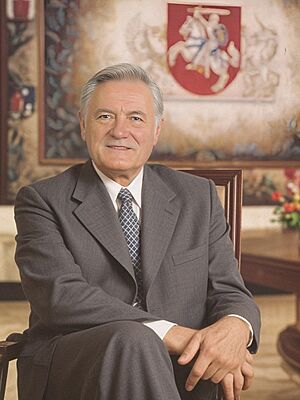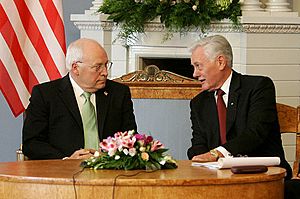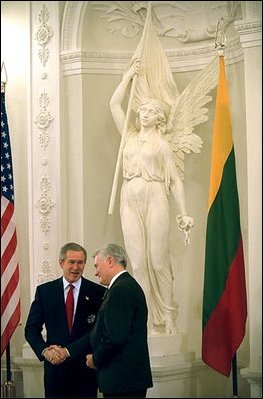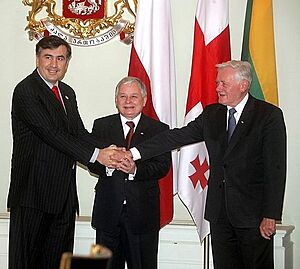Valdas Adamkus facts for kids
Quick facts for kids
Valdas Adamkus
|
|
|---|---|

Official portrait, 1998
|
|
| 5th & 7th President of Lithuania | |
| In office July 12, 2004 – July 12, 2009 |
|
| Prime Minister |
List
|
| Preceded by | Artūras Paulauskas (Acting) |
| Succeeded by | Dalia Grybauskaitė |
| In office February 26, 1998 – February 26, 2003 |
|
| Prime Minister |
List
Gediminas Vagnorius
Irena Degutienė (Acting) Rolandas Paksas Irena Degutienė (Acting) Andrius Kubilius Rolandas Paksas Eugenijus Gentvilas (Acting) Algirdas Brazauskas |
| Preceded by | Algirdas Brazauskas |
| Succeeded by | Rolandas Paksas |
| Personal details | |
| Born |
Voldemaras Adamkavičius
November 3, 1926 Kaunas, Lithuania |
| Political party | Independent |
| Spouse | |
| Alma mater | University of Munich Illinois Institute of Technology |
| Profession | Civil engineer, civil servant |
| Signature |  |


Valdas Adamkus was born Voldemaras Adamkavičius on November 3, 1926. He is a Lithuanian politician and a civil engineer. He served as the President of Lithuania two times. His first term was from 1998 to 2003. He was then re-elected and served again from 2004 to 2009.
Many people think he was one of the best leaders in modern Lithuanian history. He was married to Alma Adamkienė, who was known for her charity work. After his time as president, Adamkus continued to be involved in international projects. He is also a member of the European Academy of Diplomacy.
Contents
Early Life and Moving Abroad
Valdas Adamkus was born in Kaunas, Lithuania, in 1926. His family was Roman Catholic. He changed his name to Valdas Adamkus in 1955. His father was an early leader of the Lithuanian Air Force School. His uncle, Edvardas Adamkavičius, was a general in the Lithuanian army. When he was young, Valdas was very good at track and field. He even set a national record for running 100 meters.
As a teenager, Adamkus joined a secret group fighting against the first Soviet occupation of Lithuania in 1940. During the Nazi occupation, he helped distribute an underground newspaper that was against the Germans. In 1944, when the Soviets invaded Lithuania again, he joined the Fatherland Defense Force to fight them. However, the Soviet forces were much stronger. To avoid the second Soviet occupation, he and his family had to leave Lithuania.
Moving to the United States
Adamkus first studied at the University of Munich in Germany. In 1949, he moved to the United States. He could speak five languages: Lithuanian, Polish, English, Russian, and German. In the 1950s, he served in the United States Army Reserve's military intelligence unit.
When he arrived in Chicago, Illinois, he was a displaced person. He first worked in a car factory and then as a draftsman. In 1961, he graduated as a civil engineer from the Illinois Institute of Technology. While he was a student, Adamkus and other Lithuanians living in America gathered about 40,000 signatures. They asked the U.S. government to help stop the deportations of Lithuanians to Siberia. This petition was given to Vice President Richard Nixon. Adamkus also spoke to United Nations Secretary General Dag Hammarskjöld and President John F. Kennedy about Soviet actions in occupied Lithuania.
Working for the U.S. Environmental Protection Agency
In 1970, Valdas Adamkus joined the United States Environmental Protection Agency (EPA) when it first started. He worked in Cincinnati. In 1981, President Ronald Reagan appointed him as a regional administrator. This meant he was in charge of programs for air, water, and waste pollution in six states: Illinois, Indiana, Michigan, Minnesota, Ohio, and Wisconsin. In 1985, President Reagan gave him the President's Award for Distinguished Federal Civilian Service. This is the highest honor a government worker can receive.
In 1972, Adamkus visited Lithuania for the first time in almost 30 years. He was part of a U.S. delegation attending an environmental conference in Moscow. As the Soviet Union started to change with "perestroika", Adamkus visited his homeland more often. He worked as a regional administrator for the EPA for 16 years. He retired in 1997 after 29 years of service. When he retired, he received a letter from President Bill Clinton. He also got a Distinguished Career Award from EPA Administrator Carol Browner. The EPA region he worked for even created a new award in his honor, called the "Valdas V. Adamkus Sustained Commitment to the Environment Honor Award."
President of Lithuania
First Term (1998–2003)
Soon after leaving the EPA, Valdas Adamkus moved back to Lithuania. He decided to run for president in 1998. There was a legal challenge about whether he could run because he had lived abroad for so long. However, the court decided he was eligible. He also gave up his U.S. citizenship at the American Embassy in Vilnius. He won the election in 1998, beating Artūras Paulauskas. He served as president until 2003. He ran for re-election but was defeated by Rolandas Paksas.
Adamkus returned to politics after a scandal involving his former rival, Rolandas Paksas. Paksas was removed from office in 2004. A new election was announced, and Adamkus ran for president again. In the first round of the 2004 election, he received the most votes. Paksas could not run again because a court ruled he was not allowed to hold public office. Adamkus won the runoff election on June 27, 2004, against Kazimira Prunskienė. By 2009, he had served the two terms allowed by the Constitution of Lithuania. Dalia Grybauskaitė became the next president.
In 2003, Valdas Adamkus was named a UNESCO Goodwill Ambassador. This means he helped UNESCO, a part of the United Nations, with its goals. He was recognized for his dedication to promoting social development, cultural diversity, and international cooperation.
Second Term (2004–2009)
Foreign Relations
During his second term, Lithuania actively supported democracy in countries that used to be part of the Soviet Union, like Ukraine and Georgia. President Adamkus helped mediate during Ukraine's political crisis in 2004. He worked with other leaders to help resolve the situation when two candidates both claimed victory. He remembered asking what they could do to help, and they were told to come to Kyiv right away. The crisis was solved after a new election was held.
In 2005, Valdas Adamkus and the President of Estonia did not attend a celebration for the end of World War II in Europe. President Adamkus felt that for Lithuania, the end of the war marked the start of 50 years of Soviet occupation. The United States Congress later passed a resolution asking Russia to admit and condemn the Soviet occupation of the Baltic countries.
President Adamkus supported strong talks between European Union countries and former Soviet republics like Georgia, Ukraine, and Moldova. These countries wanted to join the EU. He showed his support for them at several meetings, including the Community of Democratic Choice in 2005 and the Vilnius Conference in 2006. Valdas Adamkus is also an Honorary Member of The International Raoul Wallenberg Foundation.
Domestic Issues
Valdas Adamkus was very popular in Lithuania. He was also recognized for his support of young people. He was actively involved in changing how the government worked in 2004 and 2006. In his 2006 speech to the nation, Adamkus said his main goals were:
- Getting more people involved in politics.
- Using money from the European Union wisely and clearly to improve life in Lithuania.
- Making improvements in government, education, science, social support, and healthcare.
- Helping government workers become more skilled.
- Creating a code of ethics for politicians.
- Allowing people to directly elect mayors and getting rid of the county system.
- Building a new nuclear power unit in Ignalina.
- Creating laws for how judges are chosen and promoted.
- Stopping "brain drain" by supporting research and higher education.
Personal Life
In 1951, Adamkus married Alma Nutautaite. They did not have any children. They helped fund the largest bell for the Kaunas Carillon, which weighs 751 kg. Alma Nutautaite passed away in May 2023 at the age of 96.
In January 2025, Adamkus was hospitalized in Vilnius. He was experiencing a worsening heart condition.
Awards and Recognition
Valdas Adamkus has received many honors from Lithuania and other countries.
Lithuanian Honors
- Order of Vytautas the Great with Golden Chain (2003)
- Lithuanian Scout Association Order of Iron Wolf (2002)
- Medal for Merits to Vilnius and the Nation (2019)
- Golden Order of the State Emblem of Lithuania (2019)
- Riflemen's Star
International Honors
- Albania: Order of Mother Theresa (2007)
- Armenia: Order of St. Meshrop Mashtots (2002)
- Austria: Grand Star of the Decoration for Services to the Republic of Austria (2009)
- Belgium: Grand Cordon of the Order of Leopold (2006)
- Bulgaria: First Class of the Order of Stara Planina (2009)
- Chile: Collar of the Order of the Merit of Chile (2008)
- Estonia: Collar of the Order of the Cross of Terra Mariana (1999), Collar of the Order of the White Star (2004)
- Europe: European of the Year (2007)
- Finland: Grand Cross with Collar of the Order of the White Rose of Finland (2002)
- France: Grand Cross of the Order of the Legion of Honour (2001)
- Georgia: St. George's Victory Order (2007)
- Germany: Grand Cross Special Class of the Order of Merit of the Federal Republic of Germany (2005)
- Greece: Grand Cross of the Order of the Redeemer (1999)
- Hungary: Grand Cross of the Order of Merit of the Republic of Hungary (1999)
- Iceland: Grand Cross of the Order of the Falcon (1998)
- Italy: Knight Grand Cross with Collar of the Order of Merit of the Italian Republic (1999)
- Japan: Grand Cordon of the Supreme Order of the Chrysanthemum (2007)
- Kazakhstan: Order of Friendship, 1st class (2000)
- Latvia: Commander Grand Cross with Chain of the Order of Three Stars (2001)
- Malta: Grand Cross of the National Order of Merit (1999)
- Netherlands: Knight Grand Cross of the Order of the Netherlands Lion (2008)
- Norway: Grand Cross of the Order of St. Olav (1998)
- Poland: Knight of the Order of the White Eagle (1999), Grand Cross of the Order of Polonia Restituta (2009)
- Portugal: Grand Collar of the Order of Prince Henry (2007)
- Romania: Collar of the Order of the Star of Romania (2001)
- Russia: St Andrew 'Dialog of Civilization' prize laureate (2002)
- Slovakia: First Class of the Order of the White Double Cross (2005)
- Spain: Knight of the Collar of the Order of Isabella the Catholic (2005)
- Ukraine: Order of Liberty (2009), First Class of the Order of Prince Yaroslav the Wise (1998), First Class of the Order of Merit (2006)
- United Kingdom: Honorary Knight Grand Cross of the Most Honourable Order of the Bath (2006)
- United States: President's Award for Distinguished Federal Civilian Service (1985), Golden Plate Award of the American Academy of Achievement (1999)
- Uzbekistan: Order For Special Merits (2002)
Honorary Degrees
Adamkus has received special honorary doctorates from many universities. These include:
- Lithuania: Vilnius University (1989), Kaunas University of Technology (1998), Lithuanian University of Agriculture (1999), Law University of Lithuania (2001), Vytautas Magnus University (2002), Lithuanian Academy of Physical Education (2004), Klaipėda University (2008), ISM University of Management and Economics (2009)
- United States: Indiana St. Joseph's College (1991), Northwestern University (1994), The Catholic University of America (1998), Illinois Institute of Technology (1999), DePaul University (2001), University of Notre Dame (2007)
- Other Countries: Eurasian University (Kazakhstan, 2000), Yerevan State University (Armenia, 2006), Baku State University (Azerbaijan, 2006), Donetsk University (Ukraine, 2006), Nicolaus Copernicus University (Poland, 2007), Tallinn University (Estonia, 2008), University of Chile (Chile, 2008), John Paul II Catholic University (Poland, 2009)
See also
 In Spanish: Valdas Adamkus para niños
In Spanish: Valdas Adamkus para niños
- List of presidents of Lithuania
- Presidential Palace, Vilnius
- Historical Presidential Palace, Kaunas
- Knight of Freedom Award


